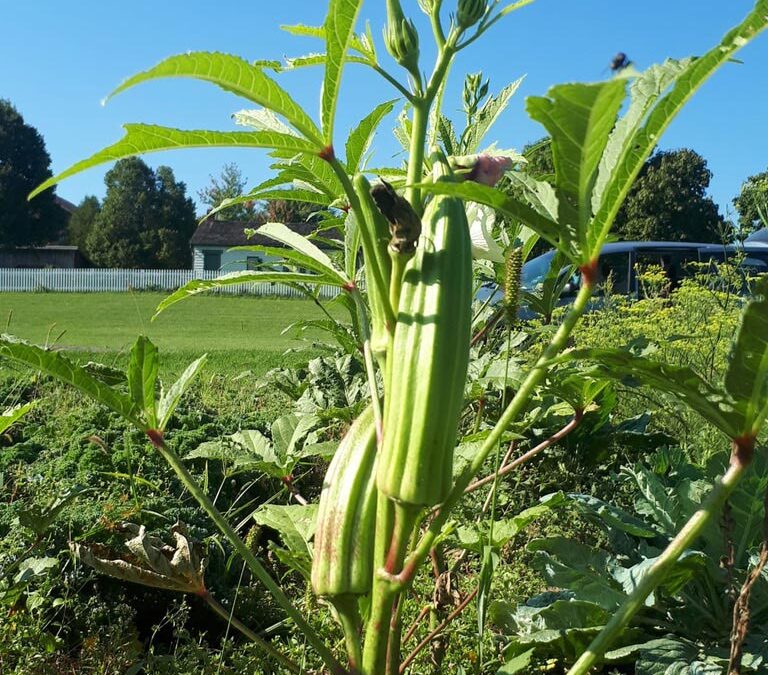A Fruitlicious Summer Awaits With Okra

Improving Health Outcomes For Pad And The Caribbean Community
March 6, 2022Our teams feature, POWA Food,
Okra is packed with nutrition and is a humble addition to many Caribbean, Afrikan meals. Consumed as a vegetable okra is a fruit and has some of the highest mineral content of any food.
Typically, this food is steamed, stewed, and sometimes fried, or added to drinks in the Caribbean, however there are numerous ways people around the world enjoy this versatile food. This summer get more minerals from this powerhouse food. Try adding raw okra to your favorite salad, slice it thick, thin, cubed or any way you like. When eaten fresh, raw, it is moist, delicately crunchy with a moderately mild delicious flavour. In its natural, raw state, it does not display the characteristic mucilaginous juice present when cooked and is a flavourful, hearty addition to any summer dish.
According to foodreference.com okra originated around Ethiopia, and was cultivated by the ancient Egyptians by the 12th century B.C. It later spread throughout North Africa and the Middle East and the Caribbean. The seed pods were eaten cooked, and the seeds were toasted and ground, used as a coffee substitute the website reports.
Okra, raw, serving size: 1 cup, 100 g
It is a good source of dietary fiber, Protein, Riboflavin, Niacin, Iron, Zinc and Copper, Vitamin A, Vitamin C, Vitamin K, Thiamin, Vitamin B6, Folate, Calcium, Magnesium, Phosphorus, Potassium and Manganese. In addition to a healthy diet okra helps to manage blood sugar in cases of type 1, type 2 diabetes.
Vitamin C 21.1 mg, 35%
Vitamin K 53.0 mcg, 66%
Thiamin 0.2 mg, 13%
Vitamin B6 0.2 mg, 11%
Folate 88.0 mcg, 22%
Magnesium 57.0 mg, 14%
Manganese 1.0 mg, 50%
Cherry and Plum Tomatoes, red, ripe, raw, serving size 1 Cup, 149 g
It is a good source of Dietary fiber, Vitamin A, Vitamin C, Vitamin K, Potassium. Tomatoes contain the antioxidant lycopene, which is linked to reduced risk of heart disease and cancer. Tomatoes is one of the few vegetables we recommend.
Facts you should know
Cooking tomatoes substantially raises the levels of beneficial compounds such as the carotenoids lycopene, lutein, and zeaxanthin, the cancer fighting nutrients.
Vitamin A 1241 IU, 25%
Vitamin C 18.9 mg, 32%
Vitamin K 11.8 mcg, 15%
Potassium 353 mg, 10%
Grapes, red or green raw, Serving size 1 cup, 151 g
It is also a good source of Vitamin C and Vitamin K and copper. Try to find grapes with seeds and eat the seeds of blend them in a high-powered blender to make a delicious smoothie. Research shows, the highest concentration of antioxidants is found in the skin and seeds. Grapes contain powerful antioxidants and may repair the damage to your cells caused by free radicals.
Vitamin C 16.3 mg, 27%
Vitamin K 22.0 mcg, 28%
Copper 0.2 mg, 10%
Plums, raw, serving size 1 cup, 165 g
It is also a good source of Dietary Fiber, Vitamin A, Vitamin C and Vitamin K. some studies show plums contain more than twice the amount of polyphenol antioxidants as other popular fruits, such as nectarines and peaches. They may improve bone health and may help reduce the risk of heart disease and diabetes. They can be consumed fresh or dried as prunes. Eating prunes has been shown to be more effective at treating constipation than many other types of laxatives, such as psyllium, which is a type of fiber often used for constipation relief.
Vitamin A 569 IU, 11%
Vitamin C 15.7 mg, 26%
Vitamin K 10.6 mcg 13%
Pears, raw, serving size 1 small, 148 g
It is also a good source of good source of Dietary Fiber and Vitamin C. Pears act as a prebiotic, which improves digestive health and promotes bowel regularity, constipation relief. Eating the skin greatly increase the fiber content.
Vitamin C 6.2 mg, 10%
Raspberries, raw, serving size 1 Cup, 123 g
It is a good source of dietary fiber Vitamin C and Magnesium
In addition to a healthy diet, they help protect against diabetes, cancer, obesity, arthritis and other conditions. Add these tasty and sometimes tangy fruits to your breakfast, lunch, dinner or dessert.
Vitamin C 32.2 mg, 54%
Manganese 0.8 mg, 41%
Research articles
https://nutritiondata.self.com/facts/vegetables-and-vegetable-products/2304/2#ixzz6Ismw4wJp
https://www.healthline.com/health/diabetes/okra
http://www.foodreference.com/html/artokra.html
Wallace, T. C., Bailey, R. L., Blumberg, J. B., Burton-Freeman, B., Chen, C. O., Crowe-White, K. M., … Wang, D. D. (2019). Fruits, vegetables, and health: A comprehensive narrative, umbrella review of the science and recommendations for enhanced public policy to improve intake. Critical Reviews in Food Science and Nutrition, 1-38. doi:10.1080/10408398.2019.1632258




